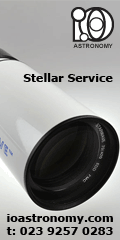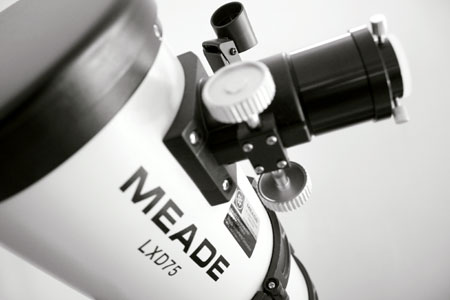Newtonian Reflector Telescopes
Newtonians (also known as catoptrics) usually use a concave parabolic primary mirror to collect and focus incoming light onto a flat secondary (diagonal) mirror that in turn reflects the image out of an opening at the side of the main tube and into the eyepiece. A bit like the picture above.
Advantages
- Lowest cost per inch of aperture compared to refractors and catadioptrics since mirrors can be produced at less cost than lenses in medium to large apertures.
- Reasonably compact and portable up to focal lengths of 1000mm.
- Excellent for faint deep sky objects such as remote galaxies, nebulae and star clusters due to the generally fast focal ratios (f/4 to f/8).
- Reasonably good for lunar and planetary work.
- Good for deep sky astrophotography (not as convenient and more difficult to use than catadioptrics).
- Low in optical aberrations and delivers very bright images.
Disadvantages
- Open optical tube design allows image-upgrading air currents and air contaminants which over a period of time will degrade the mirror coatings and telescope performance.
- More fragile than refractors or catadioptrics and this require more maintenance (such as collimation).
- Suffer from off-axis coma.
- Large apertures (over 8") are bulky, heavy and tend to be more expensive. For portability 150-200mm are best at f/4-f/8.
- Generally not suited for terrestrial applications.
- Slight light loss due to secondary (diagonal) obstruction when compared with refractors.
Dobsonian Telescopes
Most Newtonian Telescopes have been supplied on equatorial mounts. The
last few years has seen a new commercial telescope available on the market
- the Dobsonian. A Dobsonian is a simple altazimuth mounted Newtonian telescope
which is excellent for beginners and in large sizes is an economical "Light
Bucket". Simple construction means they are easy to look after and
a lot of aperture can be carted around, 200mm to 250mm Dob's can be slung
across the back seat of a car and transported anywhere.
In summary a small reflector is the best general purpose
telescope for beginners as they are good on all types of objects and for
starting astrophotography.
If you wish for the ultimate planetary telescope, and also a scope which
is virtually maintenance free then look no further than a refractor. At
the moment refractors are in vogue due to their portability, image quality
and robustness.
Dobsonian's have their place if you know the sky, love deep sky object's
and are just happy to roam the stars. The newest designs are even more portable,
and even have adapters to fit small digital cameras.
Refractor Telescopes
Refractors (also known as dioptrics) are what the average person identifies with the word "telescope", a long, thin tube where light passes in a straight line from the front objective lens directly to the eyepiece at the opposite end of the tube. Lately those focal lengths have got shorter as astrophotography matures and gets cheaper with the advent of Digital SLR Cameras with better low light performance.
Advantages
- Easy to use and reliable due to the simplicity of design.
- Little or no maintenance.
- Excellent for lunar, planetary and binary star observing especially in larger apertures.
- Good for distant terrestrial viewing.
- High contract images with no secondary mirror or diagonal obstruction.
- Colour correction is good in achromatic designs and excellent in apochromatic and fluorite designs.
- Sealed optical tube reduces imagine degrading air currents and protects optics.
- Objective lens is permanently mounted and aligned.
Disadvantages
- More expensive per inch of aperture than Newtonians or catadioptrics.
- Heavier, longer and bulkier than equivalent aperture Newtonians and catadioptrics.
- The cost and bulk factors limit the practical useful maximum size objective to small apertures.
- Less suited for viewing small and faint deep sky objects such as distant galaxies and nebulae because of practical aperture limitations.
- Focal ratios are usually long (f/11 or slower) making photography of deep sky objects more difficult. f/4 to f/7 are preferred for this.
- Some Colour aberration in achromatic designs (doublet). Apochromatic Refractors are pretty much colour free, but this is reflected in the cost.
- Poor reputation due to low quality imported toy telescopes; a reputation unjustified when dealing with a quality refractor from a reputable manufacturer.
In summary a small reflector is the best general purpose
telescope for beginners as they are good on all types of objects and for
starting astrophotography, if they are lower than f/10 focal ratio,
f/5 being very fast. 90mm f/6 is an ideal portable telescope.
If you wish for the ultimate planetary telescope, and also a scope which
is virtually maintenance free then look no further than a refractor.
Catadioptric Telescopes
Catadioptrics use a combination of mirrors and lenses to fold the optics
and form the image. There are two popular designs: the Schmidt-Cassegrain
and the Maksutov-Cassegrain. In the Schmidt-Cassegrain the light enters
through a thin aspheric Schmidt correcting lens, it then strikes the spherical
primary mirror which reflects the light out an opening in the rear of the
instrument where the image is formed at the eyepiece. Catadioptrics are
the most popular type of instrument, with the most modern design, marketed
throughout the world in 3.5" and larger apertures.
Schmidt-Cassegrain Advantages
- Best all-round, all-purpose telescope design. Combines the optical advantages of both lenses and mirrors while canceling their disadvantages.
- Excellent optics with razor sharp images over a wide field.
- Excellent for deep sky observing or astrophotography with fast films.
- Very good for lunar, planetary and binary star observing or photography.
- Excellent for terrestrial viewing or photography.
- Focal ratio generally around f/10. Useful for all types of photography. Avoid faster f/ratio telescopes (they yield lower contrast and increase aberrations). For faster astrophotography, use a Reducer/Corrector lens.
- Closed tube design reduces image degrading air currents.
- Extremely compact and portable.
- Easy to use.
- Durable and virtually maintenance free.
- Large apertures at reasonable prices and less expensive than equivalent aperture reflectors.
- Most versatile type of telescope.
- More accessories available than with other types of telescope.
- Best near focus capability of any type of telescope.
Schmidt-Cassegrain Disadvantages
- More expensive than Newtonians of equal aperture.
- Slight light loss due to secondary mirror obstruction compared to refractors.
Maksutov-Cassegrain
The Maksutov-Cassegrain design is similar to the Schmidt with basically
the same advantages and disadvantages but is not quite as good optically
given the same focal ratios. It uses a thick meniscus correcting lens
with a heavy curvature and a secondary mirror that is usually an aluminized
spot on the corrector.
The Maksutov is heavier than the Schmidt and because of the thick correcting
lens takes a long time to reach thermal stability at night in larger apertures
(over 90mm). At 150mm it's not that portable.
The Maksutov optical design typically is easier to make and should be less
expensive than the Schmidt-Cassegrain.
In summary a small reflector is the best general purpose
telescope for beginners as they are good on all types of objects and for
starting astrophotography.
If you wish for the ultimate planetary telescope, and also a scope which is virtually
maintenance free then look no further than a refractor.



